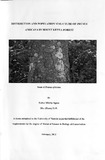| dc.description.abstract | Prunus africana has been declining over much of its geographical range due to
unsustainable harvesting of the bark for its medicinal properties. In Kenya, bark
harvesting for trade began in the 1970s from unknown forests, and the effects of this
harvesting on the species' distribution and population structure are not well known. One
of the locations where this species occur in Kenya is Mt. Kenya forest where this study
was conducted. The goal of the study was to establish the distribution and population
structure of P. africana in Mt. Kenya forest to provide information useful for knowledge
about population status, management, conservation and monitoring of the species.
Thirty eight (38) belt transects (50m x 500m) subdivided in to 25m x 25m plots were
established at varying altitudes on four broad vegetation types (moist montane, moist
intermediate, dry intermediate and dry montane) of Mt. Kenya forest and used for
sampling. Farms were estimated in acres and sampled too. The data collected on P.
africana included abundance, Diameter at breast height (DBH), and phenology. Tree
species identification and measurements were done for the three tree species nearest to P.
africana in the study plots. One-way-ANOV A was used to test for differences in
abundance and size of the species (P. africana) among vegetation types, canopy cover
classes and different altitudes.
The altitudinal distribution of P. africana ranged between 1600m to 2500m above sea
level. Four hundred and thirty six (436) individuals of P. africana were observed in 207
out of 1500 plots sampled in forest while 116 individuals were observed in 31 out of 48
farms sampled. The mean density of P. africana in the study forest was 4.8 tree/ha while
in the farms it was 5.2 trees/ha. Density in the forest varied significantly among
vegetation types (F3,34= 10.32, P< 0.05) and canopy cover classes (F2,30=21.53, P<0.05).
There was significant difference in number of individuals in different developmental
stages in forest (F2,24=11.49, P<0.05) while there was no significant difference in number
of individuals in farms (F2,12= 0.21, P> 0.05). A total of 44 tree species belonging to 23
families were found to comprise the three nearest neighbours of P. africana in different
vegetation types.
This study provided crucial information in establishing the status of P. africana in Mt.
Kenya forest. It was concluded that vegetation type, general canopy cover and altitude
are some of the factors that influence the distribution and population structure of P.
africana. The study confirmed earlier reports that the species prefers open to closed
canopy forests' | en |

